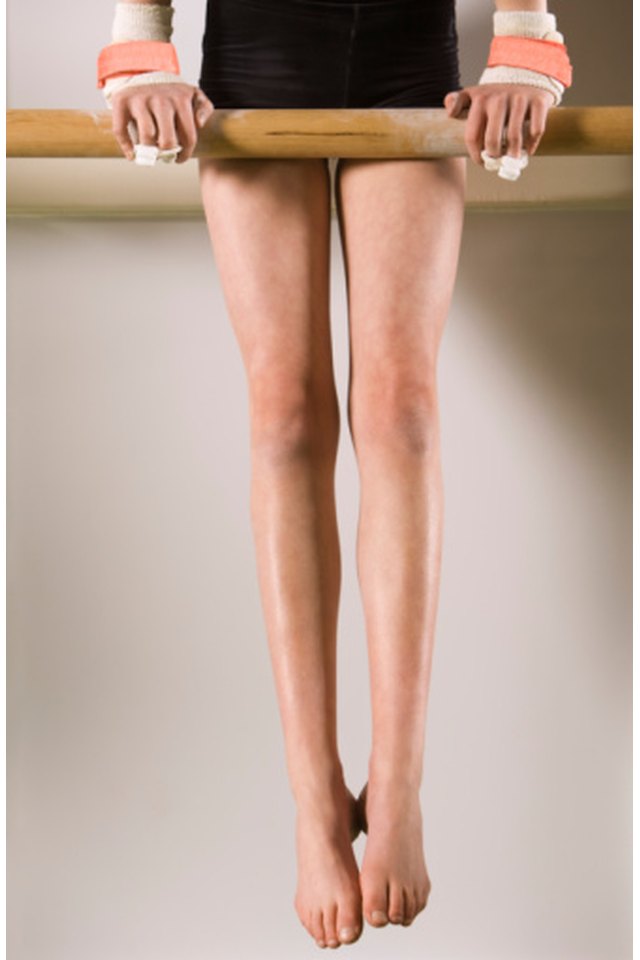How to Make Gymnastic Bars

Professionally made gymnastics bars can cost from hundreds to thousands of dollars from gymnastics equipment companies. Building a single bar by yourself may greatly reduce the cost. Gymnastics bars used in gyms are made of galvanized steel, but you can construct a practice bar out of wood materials for use in your home.
Cut your 2x4x6's into the following lengths using either a regular saw for flat cuts or a miter saw for angled cuts. Some will be flat cuts and some will be angled cuts. Use the measuring tape for precise measurements.
(1) 48" (cross support piece) - This is a flat cut. (4) 36" (side angle supports) - These are 45 degree cuts, both cuts angled in toward each other. (2) 72" (base) - These pieces do not actually need to be cut as the boards are already the right length.
Cut your 2x4x8 into two pieces between 36" and 45" in length. These are the vertical support pieces. 36" is for preschool age children. 45" inches is for older children up to a level 4 skill level, most likely children age 5-7. A young gymnast should not use a bar that is higher than their chest.
Screw the two base pieces (2x4x6) and the cross support piece (2x4x4) together in the shape of an "H" with the 4' piece horizontal between the two vertical 6' pieces. The widest portion of each piece (the 4" side) should be flush with the floor, not the 2" side. Pre-drill the holes, two for each attachment site. Use the 3" screws to attach the pieces.
Attach two angled supports (2x4x3) to each vertical support (2x4x36" or 45") by placing the angled supports on either side of the vertical support where all three ends of the boards are flush with each other. The ends of the angled supports should be angled away from the vertical support. It will look like an upside down "Y" with a third spoke in the middle where the vertical support is. Pre-drill the holes and screw the pieces together.
Combine the vertical and base supports. You may need an assistant to hold the vertical supports as you hold the base support upright. Center the vertical supports on the base and attach it to the base. Pre-drill all holes. Use the 3" screws to connect the vertical support piece and use the 2 1/2" screws on the angled support pieces, two for each attachment.
Stand the support frame up so the bar can be attached.
Cut the maple bar to 4 feet in length if it is not already the correct size. Use the 1 1/2" bar for preschool age children and the 1 3/4" bar for older children. You may want to cover the tops of the vertical supports with suede material before attaching the bar to protect your gymnastics from rough or sharp edges using the stapler.
Situate the maple bar between the two vertical supports. Make sure it is centered then screw the bar to the vertical support using the three inch screws. Coat the entire structure in a protective varnish to prevent the wood from splintering. Test the apparatus for strength before use.
Tips
You may be able to find metal brackets to use in attaching the bar to the support frame. Check gymnastics equipment retailers or construction supply stores.
Warnings
Always use at least a 4" mat under the bar to protect the gymnast and help prevent serious injury.
Place the bar away from any furniture or walls to prevent injury.
References
Tips
- You may be able to find metal brackets to use in attaching the bar to the support frame. Check gymnastics equipment retailers or construction supply stores.
Warnings
- Always use at least a 4" mat under the bar to protect the gymnast and help prevent serious injury.
- Place the bar away from any furniture or walls to prevent injury.
Writer Bio
Based in Farmington, N.M., DelSheree Gladden has been a contributing writer on eHow.com since 2008. Her primary topics of interest include yoga, dance and gymnastics, the field in which she currently works as a certified fitness intructor. DelSheree has an associate degree in English from San Juan College.
